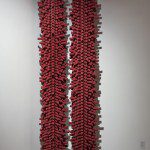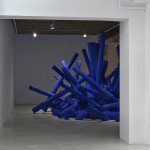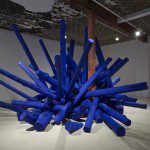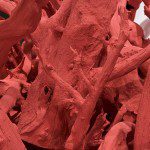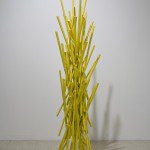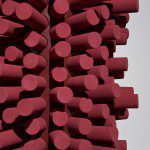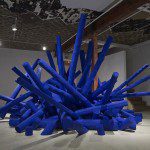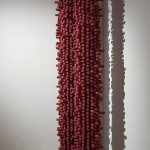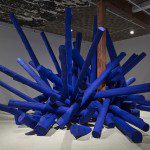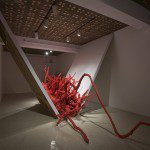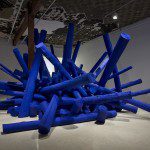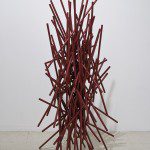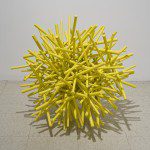Shayne Dark: Tangle Wood
Text by Michael Rattray
A consistent process of change interludes the work of Shayne Dark. With a fascination for the beauty of pure color, the new works of Dark speak to an appropriation of painting and the natural environment that seek to distort and envelope the gallery space. Relying on conventions of installation, namely the commanding of space, the scale of these new works foregrounds a specific monumentality, where the haphazardness of the natural world is presented as a singular commodity refined as art. Relying on the site-specificity of each gallery, the installed works become complicit to a random ordering of change, creating a space almost akin to a live performance. Every showing becomes subject to its surrounding, thereby appropriating the space as its own and exposing the limitations and differential values contained by the white walls of the gallery space.
A work like Red Tide will shift dependant on its installation, all the while maintaining a luminosity only attainable through the application of pure color. What appear to be individually molded pieces are in fact the collected driftwood from the artist’s walks. The wood, removed from its natural occurrence, takes on an alien and otherworldly appearance. Framed through the angular wall-like constructions, the sculpture assumes the anarchy of fire. Tangled Wood develops a similar aesthetic, but appears to be growing up straight from the gallery floor. The sculpture, upon initial glances, appears to defy convention, operating through a simulation of material that appears as natural as it does constructed. The work Last Stand, a column of over 12 feet in height, creates an order from its abstracted branches, jutting out in the round and appearing as almost jagged and sharp to the touch. Together, the works transform and involve the space of the gallery in a process of multiplicity that creates an organic construction, echoing the artists concern for creating a space that has no singular point of view.
What is fascinating about the new works is the way in which they uphold a fragility that defies their scale and monumentality. There is an unchecked potentiality, where at any moment a collapse appears imminent. The aesthetic quality of the works rests in the quiet contemplation and appreciation for the beauty of color. The works appear electric, alive, growing, but maintain a quiet status as if bearing witness to something in the present, or having borne witness in the past.


